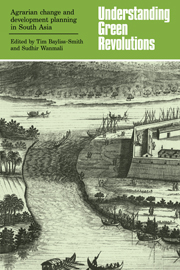Book contents
- Frontmatter
- Contents
- List of contributors
- Preface
- I Understanding Green Revolutions: an overview
- II Agrarian change at village level
- III Development planning and agrarian change
- 12 Rural-based models for rural development: the Indian experience
- 13 Planning and agrarian change in East Africa: appropriate and inappropriate models for land settlement schemes
- 14 Metropolitan expansion in India: spatial dynamics and rural transformation
- 15 Green Revolution and water demand: irrigation and ground water in Sri Lanka and Tamil Nadu
- 16 Social organisation and irrigation: ideology, planning and practice in Sri Lanka's settlement schemes
- 17 Environmental hazard and coastal reclamation: problems and prospects in Bangladesh
- 18 Beyond the Green Revolution: a selective essay
- Index
12 - Rural-based models for rural development: the Indian experience
Published online by Cambridge University Press: 25 May 2010
- Frontmatter
- Contents
- List of contributors
- Preface
- I Understanding Green Revolutions: an overview
- II Agrarian change at village level
- III Development planning and agrarian change
- 12 Rural-based models for rural development: the Indian experience
- 13 Planning and agrarian change in East Africa: appropriate and inappropriate models for land settlement schemes
- 14 Metropolitan expansion in India: spatial dynamics and rural transformation
- 15 Green Revolution and water demand: irrigation and ground water in Sri Lanka and Tamil Nadu
- 16 Social organisation and irrigation: ideology, planning and practice in Sri Lanka's settlement schemes
- 17 Environmental hazard and coastal reclamation: problems and prospects in Bangladesh
- 18 Beyond the Green Revolution: a selective essay
- Index
Summary
Urban bias in Indian planning has now become an accepted feature of all academic, and to some extent even policy, debates on rural development in that part of the world. This urban bias manifests itself in many ways and is found even in the ‘unconscious assumptions of the planners themselves’ (Lipton, 1968). B.H. Farmer in his work has analysed several instances of such assumed, and indeed real, urban bias in the macro-planning of rural development in India. It was at the end of this fieldwork for his project Green Revolution? (1977) that Farmer became convinced of the incomplete understanding of countryside in existing literature on Indian rural development. He noted in a paper presented to the Second Indo-British Geography Seminar that the urban-rural relationships in India are between towns and agriculturalists and not between towns and commuters/holiday-makers/ retired townspeople (Farmer, 1975). With a characteristic humility, Farmer described this statement as ‘so trite as to be unworthy of a paper intended for an intelligent and informed readership’. Yet what he had to say on this aspect is not insignificant. There are examples of studies on urban-rural relationships which completely lack the rural view; which demonstrate unwillingness to discuss rural attitudes and problems in anything but a rather ‘general and unrealistic way’ (Lipton, 1968); and which recommend imposition of urban (or western) ideas for the solution of Indian problems. Farmer strongly recommended that nothing short of a complete reversal of the current angle of view (which is urban based) is likely to rectify the situation (Farmer, 1975).
- Type
- Chapter
- Information
- Understanding Green RevolutionsAgrarian Change and Development Planning in South Asia, pp. 253 - 269Publisher: Cambridge University PressPrint publication year: 1984



